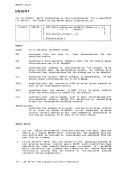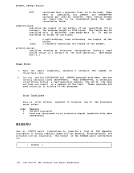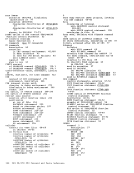r---------,
fnASSEMBLE fn CNTRL fn UPDTABC fn UPDTIYZ fn AUXLIST L---------J fn FIIOl fn FIX02 update fn (ctl
r----------,I I , I I I I I L----------J
$fnASSEMBLE fn UPDLOG fn UPDATES UPDATE fn fn CNTB1, fn fn tfn fn in Update," except that the CNTRL file contains: MACS CMSLIB TWO UPDTABC ONE UPDTXYZ TEXT AITXLIST !Q! in the filetype AUXLIST indicates that this is the filetype of an auxiliary control file that contains an additional list of updates. The
firstthree characters of the filetype of an auxiliary control file must
beanything. The filename must be the same as the source input file.
An auxiliary file may also be specified as:
xxxxxAUX in the control file. For example, the record: FIX TEST AUX identifies the auxiliary file fn AUITEST. Note that if you give an auxiliary control file the filetype AUXPTF, the UPDATE command assumes that it is a simple update file and does not
treat it as an auxiliary file. Also, if the update level identifier isPTF, the UPDATE command assumes a simple update file.
PREFERREDAUX FILE: A preferred AUI file may be specified. A preferred Aui-file-contains-the version of an update that applies to your version
of the source file. (There may be more than one version of the same
update if there is more than one version of the source file. For
example, you need one version for the source file that has a system
extension program product installed, and you need another version for
thesource file that does not have a program product installed.) When you specify an auxiliary control file, you can specify more than
one filetype. The first filetype indicates a file thatUPDATE uses only
on one condition: the files that the second and subsequent filetypes
indicate do not exist. If they do exist, thisAUX file entry is ignored
and no updating is done. The files that the second and subsequent
filetypes indicate are preferred because, if they exist,UPDATE does not
use the file that the first filetype indicates. For example, assume
that the file 'fnASSEMBLE' does exist. The control file MYKODS CNTRL: Section 2. CMS Commands 209
fn
r----------,
$fn
first
be
An auxiliary file may also be specified as:
xxxxx
treat it as an auxiliary file. Also, if the update level identifier is
PREFERRED
of the source file. (There may be more than one version of the same
update if there is more than one version of the source file. For
example, you need one version for the source file that has a system
extension program product installed, and you need another version for
the
one filetype. The first filetype indicates a file that
on one condition: the files that the second and subsequent filetypes
indicate do not exist. If they do exist, this
and no updating is done. The files that the second and subsequent
filetypes indicate are preferred because, if they exist,
use the file that the first filetype indicates. For example, assume
that the file 'fn






















































































































































































































































































































































































































